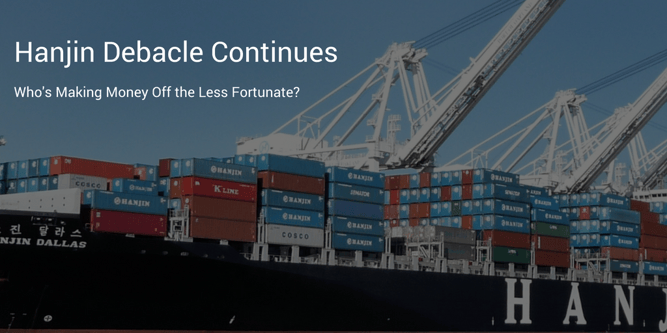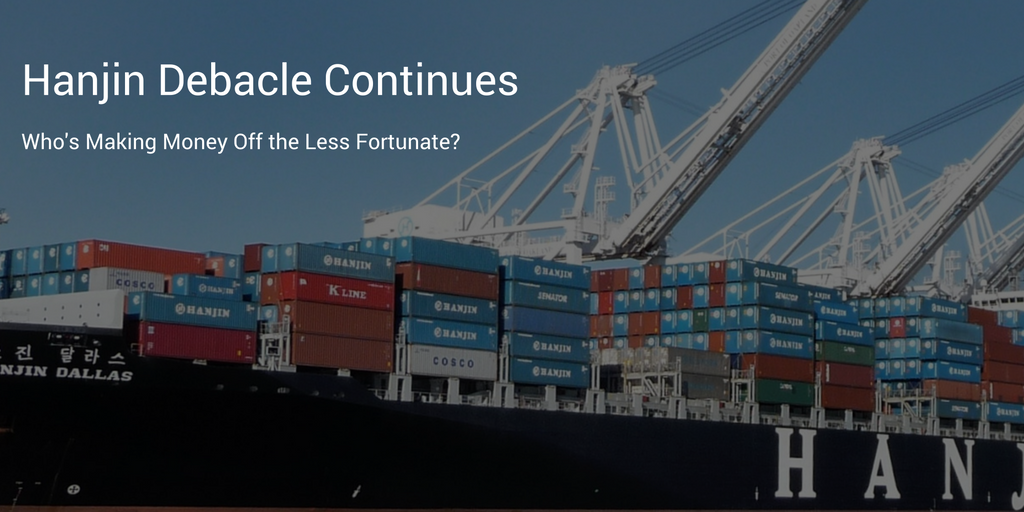
We're now 7 weeks into the morass, and to be frank, things are not much clearer today than when Hanjin sought for protection in the US bankruptcy court. While Hanjin is returning some ships to their owners, the most important questions -those regarding cargo and the containers – are still unanswered. When will cargo be delivered? Or at least released to their owners? When will the containers be returned, or at least released, to their owners? Here is a rundown of the current situation.
Quick Recap
After Hanjin filed for bankruptcy in early September, Hanjin stopped taking new shipments. The refusal of ports to handle Hanjin’s cargo stranded 45 ships at sea, with some 30-35 others in ports worldwide or just outside awaiting a berth. The shipping digests and blogs were then full of stories of ships under arrest, ships fleeing to Busan, and other Hanjin ships refused transit at the Suez and Panama Canals due to the parent company's inability to pay the canal tolls and the various port charges to unload.
Then as the Hanjin Group dithered on paying their bills, and the lawyers began to circle, the situation worsened. The container companies petitioned to have their containers arrested, or at least seized so Hanjin could not sell them, and the beneficial cargo owners screamed for release of their goods.
Resolution to the Mess
Ten days ago, a partner at the American law firm Roberts & Kehagarias, informed a group of customs brokers, freight forwarders, NVOCCs, and insurers that any intermediaries with claims should move quickly to file a claim in the case in the South Korean court. Bankruptcy protection has been extended in the United States under Chapter 15, a little-known part of U.S. bankruptcy code that allows for improved legal coordination for international bankruptcy proceedings. Because the case was first filed in South Korea, the U.S. case and protections are secondary to those primary South Korean proceedings. In order to ensure that any claims under these proceedings are considered, forwarders with claims are recommended to secure legal counsel and act quickly to submit those claims in South Korea.
Cargo owners, NVOCC's, Hanjin's vendors, and port and terminal operators are all struggling through the complications of cargo stranded by Hanjin’s bankruptcy. When Hanjin filed for bankruptcy in the South Korean court on August 31, some 80 vessels either owned or chartered by Hanjin were left without the necessary funding to dock and unload cargo at ports worldwide. Hanjin has been seeking the protections of bankruptcy courts in other countries, while entities doing business with Hanjin have worked hard to recover their cargo and receive payment for their services.
Hanjin also secured a provisions protective order from U.S. Bankruptcy Judge John Sherwood to prevent the company’s creditors from seizing ships or property, and to allow cargo owners to make arrangements to retrieve their freight. Further instructions from Judge Sherwood allow Hanjin to spend money to dock at U.S. ports, and to unload vessels that have been stranded worldwide following the initial bankruptcy filing.
Ports Making Cash on the Less Fortunate
As the Hanjin ships unload their containers, U.S. ports have collected money up front from a Hanjin emergency fund, and levied significant fees on cargo owners to recover that freight. The Ports of Los Angeles and Long Beach have unloaded several Hanjin ships while the Port of Houston initially suspended the movement of nearly 400 Hanjin containers, then charged cargo owners to pick up imports they had already paid for without payment of demurrage or additional fees. Other U.S. ports have charged exporters to dray out loaded Hanjin containers, re-load goods and re-book them on another carrier, and pay demurrage fees while the containers sat outside the terminal.
As a result of these fees, a group of NVOCCs including Apex Maritime, Carolina Ocean Lines, Kuehne + Nagel, Mitsubishi Logistics America, Domek Logistics, MIQ Global Logistics,, Dynamic Worldwide Logistics, and WorldBridge Logistics have filed a request with Judge Sherwood to extend his protective order to include those companies trying to recover their freight. Clarification and extension of the protective order would, ideally, allow NVOCCs and other shippers to reclaim cargo while paying only the fees as contracted by Hanjin with third parties. Such an order would ensure that those third parties are not able to inflate costs for shippers and cargo owners who have been left in a lurch by the Hanjin bankruptcy.
It remains to see if Judge Sherwood's order is followed and the many cargoes are released in time for the upcoming holiday season.
Quick Facts
- U$14 Billion – the estimated value of cargo tied up globally as Hanjin ships idle outside ports that won’t let them in.
- 400,000 – the estimated number of containers stranded on Hanjin ships.
- 8,300 – the approximate number of cargo owners involved
- US $38 Million – the value of goods, mostly TVs, and appliances that Samsung Electronics has said it has stuck aboard 2 Hanjin ships.
- 8% – the trans-Pacific trade volume for the U.S. market carried by Hanjin
- 141 – the number of ships Hanjin has (97 containers ships, 44 bulk carriers). More than half are blocked from docking, and 4 have been seized as of September 11, 2016.
- U$5.5 Billion – Hanjin’s debts as of June 30, 2016.
(sources: Hanjin Shipping, Korea Shipowners Association, Thomas Reuters Eikon)






